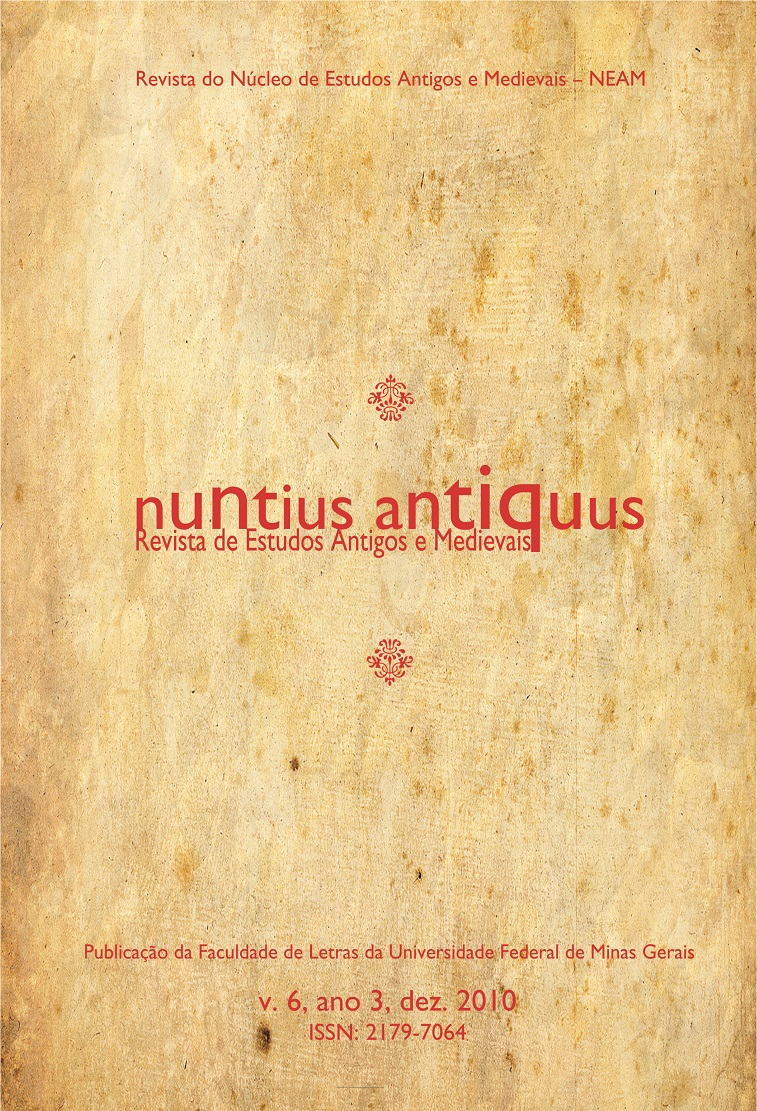A deusa compõe um “mito”: o jovem Odisseu em busca de veneno (Odisseia I, 255-68)
DOI:
https://doi.org/10.17851/1983-3636.6..7-27Palavras-chave:
Odyssey, Iliad, theme, myth, archerResumo
This paper explores the inter- and extradiegetical functions of a story about Odysseus narrated by Athena to Telemachos in Odyssey 1, 255-68. It is argued that the representation of Odysseus in search of poison for his arrows need not to be thought first and foremost as a non-Homeric element or a morally disturbing action, for it may be analyzed by means of epic themes (specially by the mêtis-megatheme) explored not only in the Odyssey but in the Iliad as well. Besides, this story anticipates and condenses the plot of the poem.
Referências
ANDERSEN, Ø. The Diomedesgestalt in der “Ilias”. Oslo: Universitetsvorlaget, 1978.
BAKKER, E. Polyphemos. Colby Quarterly. Waterville, n. XXXVIII, p. 135-50, 2002.
BERGOLD, W. Der Zweikampf des Paris und Menelaos. Bonn: Adolf Habelt, 1977.
BOLLACK, J. Ulysse chez les philologues. In. La Grèce de personne. Paris: Seuil, 1997, p. 29-59.
CAIRNS, D. L. Aidôs: the psychology and ethics of honour and shame in ancient Greek literature. Oxford: University Press, 1993.
CLAY, J. S. The wrath of Athena. Gods and men in the “Odyssey”. Lanham: Rowman & Littlefield, 1997.
CLAY, J. S. Odyssean animadversions. In: MONTANARI, F. (Org.). Omero tremila anni dopo. Roma: Edizioni di Storia e Letteratura, 2002, p. 73-83.
DANEK, G. Studien zur Dolonie. Wien: Österreichischen Akademie der Wissenschaften, 1988.
DANEK, G. Epos und Zitat. Studien zu den Quellen der Odyssee. Wien: Österreichischen Akademie der Wissenschaften, 1998.
DIMOCK, G. E. The unity of the “Odyssey”. Amherst: University of Massachusetts Press, 1989.
DIRLMEIER, F. Die Giftpfeile des Odysseus. Heidelberg: Carl Winter, 1966.
DUÉ, C.; EBBOTT, M. “Iliad” 10 and the poetics of ambush. A multitext edition with essays and Commentary. Hellenic Studies. Washington D.C.: Center for Hellenic Studies, 2010. v. XXXIX.
EDWARDS, A. T. Achilles in the “Odyssey”. Königstein: Hain, 1985.
FENIK, B. Studies in the “Odyssey”. Hermes Einzelschriften. Wiesbaden: Franz Steiner, 1974. v. XXX.
FORD, A. Homer: the poetry of the past. Ithaca: Cornell University Press, 1992.
HAFT, A. J. “The city-sacker Odysseus” in “Iliad” 2 and 10. Transactions of the American Philological Association. Baltimore, n. CXX, p. 37-56, 1990.
HAINSWORTH, J. B. The “Iliad”: a Commentary. Cambridge: University Press, 1993. v. III.
HALLIWELL, S. Greek laughter. A study of cultural psychology from Homer to early Christianity. Cambridge: University Press, 2008.
HESIOD. The shield; Catalogue of women; Other fragments. Edited and translated by Glenn W. Most. Cambridge, Mass.: Harvard University Press, 2007.
HÖLSCHER, U. Die Odyssee. Epos zwischen Märchen und Roman. München: C. H. Beck, 1988.
HOMERI Odyssea. Recognovit Helmut van Thiel. Hildesheim: Olms, 1991.
HOMERI Ilias. Iterum recognovit Helmut van Thiel. Hildesheim: Olms, 2010.
HUNT, P. Military forces. In: SABIN, P.; van WEES, H.; WHITBY, M. (org.) The Cambridge history of Greek and Roman warfare. Cambridge: University Press, 2008, p. 108-146. v. I.
JONG, I. J. F. de. Narrators and focalizers. The presentations of the story in the “Iliad”. Amsterdam: Grüner, 1987.
JONG, I. J. F. de. A narratological Commentary on the “Odyssey”. Cambridge: University Press, 2001.
von KAMPTZ, H. Homerische Personennamen. Sprachwissenschaftliche und historische Klassifikation. Göttingen: Vandenhoeck & Ruprecht, 1982.
KELLY, A. How to end an orally-derived epic poem? Transactions of the American Philological Association. Baltimore, n. CXXXVII, p. 371-402, 2007.
LATACZ, J. et al. Homer “Ilias”: Gesamtkommentar. Band II: Zweiter Gesang. Faszikel 2: Kommentar. München: Saur, 2003.
LORD, A. B. The singer of tales. Cambridge, Mass.: Harvard University Press, 1960.
LOUDEN, B. The “Odyssey”. Structure, narration and meaning. Baltimore: Johns Hopkins University Press, 1999.
MACKIE, H. Talking Trojan. Speech and community in the “Iliad”. Lanham: Rowman & Littlefield, 1996.
MALKIN, I. The returns of Odysseus. Colonization and ethnicity. Berkeley: University of California Press, 1998.
MARTIN, R. P. The language of heroes. Speech and performance in the “Iliad”. Ithaca: Cornell University Press, 1989.
MERKELBACH, R. Untersuchungen zur Odyssee. 2. ed. München: Beck, 1969.
MUELLNER, L. C. The meaning of Homeric eukhomai through its formulas. Innsbruck: Institut für Sprachwissenschaft, 1976.
NAGY, G. The best of the Achaeans. Concepts of the hero in archaic Greek poetry. Baltimore: Johns Hopkins University Press, 1979.
NAGY, G. Pindar’s Homer. The lyric possession of an epic past. London: Johns Hopkins University Press, 1990.
PAPADOPOULOU, T. Heracles and Euripidean tragedy. Cambridge: University Press, 2005.
PERADOTTO, J. Man in the middle voice. Name and narrative in the “Odyssey”. Princeton: University Press, 1990.
REECE, S. The strangers welcome. Oral theory and the aesthetics of Homeric hospitality scene. Ann Arbor: University of Michigan Press, 1993.
RICHARDSON, N. The “Iliad”: a Commentary. Cambridge: University Press, 1993. v. VI.
RICHARDSON, N. Three Homeric hymns: to Apollo, Hermes, and Aphrodite. Cambridge: University Press, 2010.
RIJKSBARON, A. Discourse cohesion in the proem of Hesiod’s “Theogony”. In: BAKKER, S.; WAKKER, G. (Org.). Discourse cohesion in ancient Greek. Amsterdam Studies in Classical Philosophy. Leiden: Brill, 2009. v. XVI.
ROUSSEAU, P. L’intrigue de Zeus. Europe. Paris, n. QCCCLXV, p. 120-158, 2001.
RÜTER, K. Odysseeinterpretationen. Untersuchungen zum ersten Buch und zur Phaiakis. Editado por K. Matthiessen. Göttingen: Vandenhoeck & Ruprecht, 1969.
SCHNAPP-GOURBEILLON, F. Lions, héros, masques. Les répresentations de l’animal chez Homère. Paris: Maspero, 1981.
SNELL, B. (Begründer). Lexikon des frühgriechischen Epos. 4 v. Göttingen: Vandenhoeck & Ruprecht, 1955-2010.
STEINER, D. Homer: “Odyssey”, books XVII and XVIII. Cambridge: University Press, 2010.
STOEVESANDT, M. Homer “Ilias”: Gesamtkommentar. Band IV: Sechster Gesang. Faszikel 2: Kommentar. Berlin: Walter de Gruyter, 2008.
TAPLIN, O. Homeric soundings. The shaping of the “Iliad”. Oxford: University Press, 1992. van THIEL, H. Odysseen. Basel: Schwabe, 1988.
WALSH, T. R. Fighting words and feuding words. Anger and the Homeric poems. Lanham: Rowman and Littlefield, 2005.
van WEES, H. Homeric warfare. In: Morris, I.; Powell, B. (Org.). A new Companion to Homer. Leiden: Brill, 1997.
WEST, M. L. Indo-European poetry and myth. Oxford: University Press, 2007.
WEST, S. Books i-iv. In: Hainsworth, J. B.; Heubeck, A.; ______. (Org.). A Commentary on Homer’s “Odyssey”. Oxford: University Press, 1988. V. I, p. 49-245.










